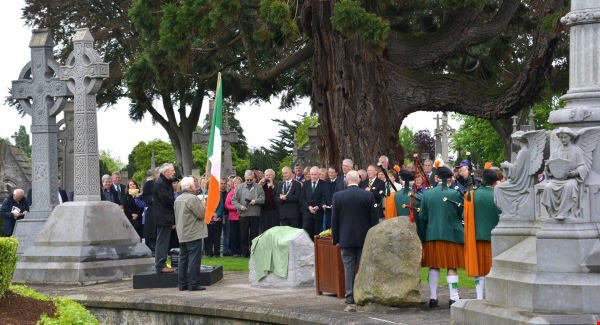
Relatives of those who fought and died in the Easter Rising are set to take legal action to stop a wall being unveiled at Glasnevin cemetery which commemorates the British army dead alongside those who were killed while attempting to liberate Ireland from that army.
Opposition has been mounting in recent months to the ‘necrology’ wall, which is due to be unveiled by the Glasnevin Trust early next month. The trust has described the wall as an initiative “to remember in a non-judgemental way, all who died as a result of the conflict from 1916-1923”.
James Connolly Heron of 1916 Relatives Centenary Initiative described the plan as “disgraceful”.
“That the British army dead are to be included on this wall is extraordinary and bizarre. We were not ever contacted about it and neither were a number of other groups who have complained about it to the trust. It has just been pushed through without our involvement. It is disgraceful”.
Donna Cooney of the 1916 relatives group GPO Garrison said her group is considering legal action. “It is something we might have to consider on the grounds that they don’t have our permission or any kind of agreement from us. It is hard to believe that they haven’t tried to consult us around inscribing the names of the British army alongside our relatives, those who were executed by Crown forces,” she said.
“We are all opposed in principle to any proposal to locate a wall, plaque or register in Glasnevin Cemetery or elsewhere upon which names of British Army personnel will be inscribed alongside 1916 volunteers who were killed in action or executed by Crown forces. It is, in our view, a deeply insulting and bizarre proposal”. According to Ms Cooney, the Glasnevin authorities did not consult with the 1916 Relatives Association or descendants of the executed 1916 signatories to the Proclamation individually or as a group
Roderic Wilson, the son of Fiona Connolly, the youngest daughter of James Connolly, said: “I cannot understand how any Irish person can contemplate, never mind propose, that the names of British army personnel be inscribed at Glasnevin Cemetery alongside those killed or illegally executed during the Easter Rising. This would not occur in any other country”.
The plans for the wall were announced in October of last year, after the Glasnevin Trust collated the names of every person who lost their life in the battle between April 24 and April 29, 1916.
Many of the key figures from the Easter Rising, which kick-started Irish independence, were laid to rest in Glasnevin Cemetery - some after being executed by British soldiers.
Glasnevin is also the final resting place for Roger Casement, Countess Markievicz, Michael Collins and former Irish President Eamon de Valera.
Ms Nic Eanruig said that the group find the plans “abhorrent”. “The membership of the Association were clearly of the opinion that the very idea of this wall was abhorrent to them,” she said.
![[Irish Republican News]](https://republican-news.org/graphics/title_gifs/rn.gif)
![[Irish Republican News]](https://republican-news.org/graphics/title_gifs/harp.gif)

